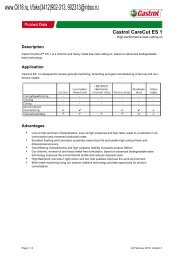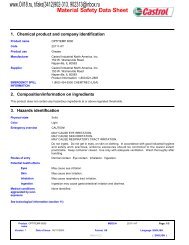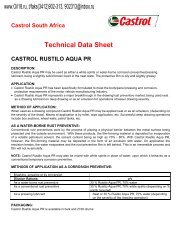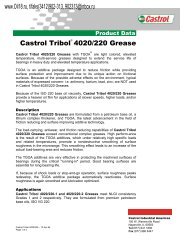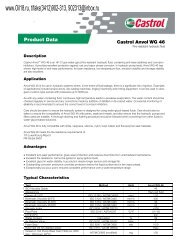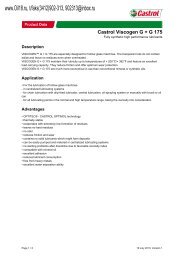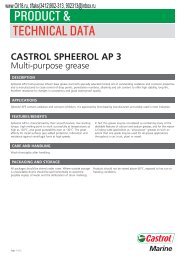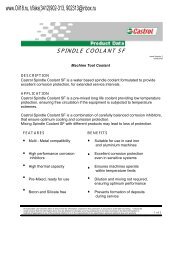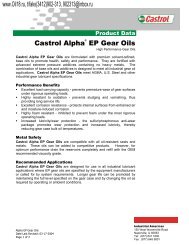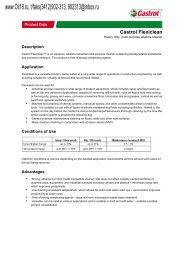9468 Hysol GS (English (GB)) BP EU SDS - United Kingdom [UK ...
9468 Hysol GS (English (GB)) BP EU SDS - United Kingdom [UK ...
9468 Hysol GS (English (GB)) BP EU SDS - United Kingdom [UK ...
You also want an ePaper? Increase the reach of your titles
YUMPU automatically turns print PDFs into web optimized ePapers that Google loves.
4 .<br />
First-aid measures<br />
Eye contact<br />
Skin contact<br />
Inhalation<br />
Ingestion<br />
In case of contact, immediately flush eyes with a copious amount of water for at least 15 minutes. Obtain<br />
medical attention immediately.<br />
Wash contaminated skin with soap and water. Remove contaminated clothing and shoes. Wash clothing<br />
before reuse. Clean shoes thoroughly before reuse. Get medical attention if irritation develops.<br />
If inhaled, remove to fresh air. Get medical attention if symptoms appear.<br />
Do NOT induce vomiting unless directed to do so by medical personnel. Never give anything by mouth to<br />
an unconscious person. Wash out mouth with water if person is conscious. If large quantities of this<br />
material are swallowed, call a physician immediately.<br />
5 .<br />
Fire-fighting measures<br />
Extinguishing media<br />
Suitable<br />
Not suitable<br />
Hazardous decomposition<br />
products<br />
Unusual fire/explosion hazards<br />
Special fire-fighting<br />
procedures<br />
Protection of fire-fighters<br />
In case of fire, use water fog, foam, dry chemical or carbon dioxide extinguisher or spray. Fire water<br />
contaminated with this material must be contained and prevented from being discharged to any waterway,<br />
sewer or drain.<br />
Do not use water jet.<br />
These products are carbon oxides (CO, CO2), nitrogen oxides (NO, NO2 etc.). Some metallic oxides.<br />
This material is not explosive as defined by established regulatory criteria.<br />
None identified.<br />
Fire-fighters should wear self-contained positive pressure breathing apparatus (SCBA) and full turnout<br />
gear.<br />
6 . Accidental release measures<br />
Personal precautions<br />
Environmental precautions<br />
and clean-up methods<br />
Personal protection in case of<br />
a large spill<br />
Immediately contact emergency personnel. Keep unnecessary personnel away. Use suitable protective<br />
equipment (See Section: "Exposure controls/personal protection"). Follow all fire fighting procedures (See<br />
Section: "Fire-fighting measures").<br />
If emergency personnel are unavailable, contain spilled material. For small spills add absorbent (soil may<br />
be used in the absence of other suitable materials) scoop up material and place in a sealed, liquid-proof<br />
container for disposal. For large spills dike spilled material or otherwise contain material to ensure runoff<br />
does not reach a waterway. Place spilled material in an appropriate container for disposal. Avoid contact<br />
of spilt material with soil and prevent runoff entering surface waterways. See Section 13 for Waste<br />
Disposal Information.<br />
Splash goggles. Full suit. Boots. Gloves. Suggested protective clothing might not be sufficient; consult a<br />
specialist BEFORE handling this product.<br />
7 .<br />
Handling and storage<br />
Handling<br />
Storage<br />
Do not get in eyes. Avoid breathing vapour or mist. Avoid prolonged or repeated contact with skin. Avoid<br />
contact of spilled material and runoff with soil and surface waterways. Wash thoroughly after handling.<br />
Keep container tightly closed. Keep container in a cool, well-ventilated area. Protect from freezing.<br />
8 . Exposure controls/personal protection<br />
Ingredient name<br />
Distillates (petroleum), hydrotreated, light naphthinic<br />
(Highly refined mineral oil)<br />
Ethylene glycol; ethanediol<br />
Occupational exposure limits<br />
EH40-OES (<strong>United</strong> <strong>Kingdom</strong> (<strong>UK</strong>)).<br />
STEL: 10 mg/m 3 15 minute(s). Form: Oil mist, mineral<br />
TWA: 5 mg/m 3 8 hour(s). Form: Oil mist, mineral<br />
EH40-WEL (<strong>United</strong> <strong>Kingdom</strong> (<strong>UK</strong>), 1/2005). Skin<br />
STEL: 104 mg/m 3 15 minute(s).<br />
STEL: 40 ppm 15 minute(s).<br />
TWA: 52 mg/m 3 8 hour(s).<br />
TWA: 20 ppm 8 hour(s).<br />
Boric acid ACGIH TLV (<strong>United</strong> States, 1/2005).<br />
STEL: 6 mg/m 3 15 minute(s).<br />
TWA: 2 mg/m 3 8 hour(s).<br />
Where there are no regulatory exposure limits, for information and guidance, the ACGIH values are included.<br />
For further information on these please consult your supplier.<br />
Whilst specific OELs for certain components are included in this <strong>SDS</strong>, it should be noted that other components of the preparation will be<br />
present in any mist, vapour or dust produced. For this reason, the specific OELs may not be applicable to the product and are provided for<br />
guidance purposes.<br />
Product name <strong>Hysol</strong> <strong>GS</strong><br />
Product code<br />
454182-<strong>GB</strong>03<br />
Version 3 Date of issue 24 February 2006<br />
Format <strong>United</strong> <strong>Kingdom</strong> Language<br />
(<strong>UK</strong>)<br />
Build 7.2.6 (<strong>United</strong> <strong>Kingdom</strong>)<br />
Page: 2/5<br />
ENGLISH<br />
( ENGLISH )




